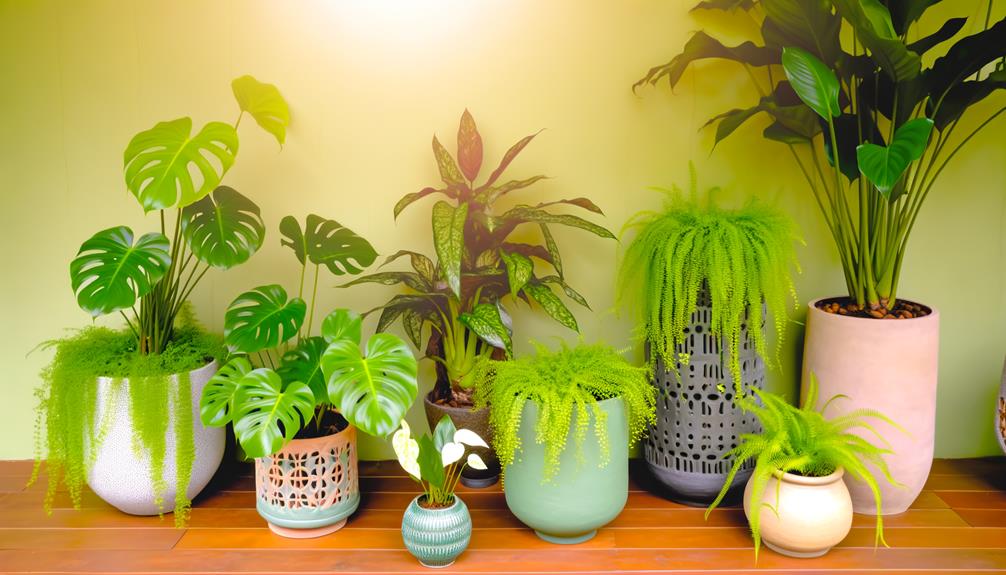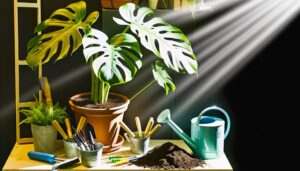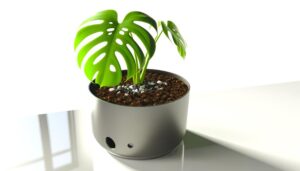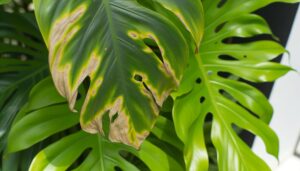What Plants Go Well With Monstera Deliciosa?
Pairing Monstera Deliciosa with plants like Pothos, Snake Plant, and Philodendron enhances your indoor garden's visual appeal. These plants thrive in indirect light and have complementary growth habits.
Pothos and Philodendrons share similar water needs, while Snake Plants and ZZ Plants tolerate low humidity, providing balance. Peace Lilies and Calatheas add textural diversity and lush greenery.
Rubber Plants and Fiddle Leaf Figs create vertical interest and harmonize the aesthetic. Ensure each plant's specific requirements for light, water, and humidity are met.
Discover specific care tips and best arrangements for a thriving, aesthetically pleasing plant collection.

Key Takeaways
- Pothos and Philodendron enhance visual appeal and share similar care needs with Monstera.
- Snake Plant and ZZ Plant thrive in indirect light and improve indoor air quality.
- Peace Lily complements Monstera's humidity and light requirements, adding aesthetic diversity.
- Boston Fern's layered foliage pairs well with Monstera, enhancing humidity levels and texture.
- Calathea, Rubber Plant, and Fiddle Leaf Fig thrive in similar conditions, offering varied leaf structures.
Pothos
Pothos, scientifically known as Epipremnum aureum, is an ideal companion plant for Monstera deliciosa due to its similar light and water requirements. Both plants thrive in indirect light, making them perfect for indoor environments.
You'll want to water Pothos when the top inch of soil feels dry, ensuring its roots don't sit in water, which could lead to root rot. Pothos prefers well-draining soil, similar to Monstera, so a mix containing peat moss, perlite, and pine bark works well.
Additionally, Pothos can tolerate varying humidity levels, complementing Monstera's needs. To promote healthy growth, incorporate a balanced liquid fertilizer every 4-6 weeks during the growing season. Prune regularly to maintain its shape and encourage fuller foliage.
Snake Plant
Another excellent companion for Monstera deliciosa is the Snake Plant, known scientifically as Sansevieria trifasciata, which thrives in similar light conditions and offers an appealing contrast with its upright, sword-like leaves. Both plants prefer indirect light and can tolerate low light, making them ideal for indoor environments.
The Snake Plant's vertical growth habit complements the Monstera's sprawling nature, creating a visually balanced arrangement. Watering requirements for both plants are minimal; allow the soil to dry between waterings to prevent root rot. Snake Plants also improve indoor air quality by removing toxins such as formaldehyde and benzene.
Philodendron
Philodendrons, particularly Philodendron hederaceum, make excellent companions for Monstera deliciosa due to their similar care requirements and complementary growth patterns. Both species thrive in indirect light and prefer high humidity levels, making them ideal for the same environment. Additionally, their aerial roots and climbing habits create visually appealing layers.
Here's how to optimize their cohabitation:
- Lighting: Place both plants in bright, indirect light to prevent leaf burn and encourage healthy growth.
- Watering: Maintain consistent soil moisture for both, but avoid waterlogging to prevent root rot.
- Humidity: Increase ambient humidity using a humidifier or pebble tray to mimic their natural tropical habitat.
ZZ Plant
Despite their contrasting appearances, the ZZ plant (Zamioculcas zamiifolia) pairs well with Monstera deliciosa due to its similarly low-maintenance care requirements and tolerance for indirect light. The ZZ plant's rhizomes store water, making it drought-tolerant, which aligns with the Monstera's moderate watering needs.
Both plants thrive in well-draining soil, reducing the risk of root rot. You'll find that the ZZ plant's glossy, dark green leaves complement the Monstera's iconic split foliage, creating visual diversity. Additionally, the ZZ plant can handle lower humidity levels, making it versatile in varied indoor environments.
Place them together in a bright, indirect light location to optimize growth. This pairing not only enhances your space aesthetically but also simplifies your plant care routine.
Peace Lily
Pairing a Peace Lily with your Monstera Deliciosa is a practical choice due to their similar light and water needs. Both plants thrive in indirect light and appreciate consistent moisture, making them easy to maintain together.
Additionally, the Peace Lily's sleek, dark green leaves and white blooms visually complement the Monstera's large, fenestrated foliage.
Light and Water Needs
Peace Lilies flourish in bright, indirect light and require consistently moist soil to maintain their lush, green foliage. To achieve the best growth, follow these guidelines:
- Light Intensity: Position your Peace Lily in a spot with filtered sunlight. Avoid direct sunlight, as it can damage the leaves.
- Watering Schedule: Maintain the soil evenly moist but not waterlogged. Water when the top inch of soil feels dry to the touch.
- Humidity Levels: Peace Lilies prefer high humidity. You can increase humidity by misting the plant regularly or placing it near a humidifier.
Visual Complementarity
To create a visually striking indoor garden, consider the contrasting textures and colors of the Peace Lily's sleek, dark green leaves and the Monstera Deliciosa's large, fenestrated foliage. The Peace Lily (Spathiphyllum) offers a refined, glossy leaf surface, complementing the Monstera's distinctive split leaves. This combination provides a dynamic visual balance, enhancing your space.
| Feature | Peace Lily (Spathiphyllum) | Monstera Deliciosa |
|---|---|---|
| Leaf Color | Dark Green | Light to Dark Green |
| Leaf Shape | Oval, Smooth | Large, Split |
| Growth Habit | Compact, Upright | Spreading, Climbing |
For optimal growth, ensure both plants receive indirect sunlight and maintain consistent moisture levels. This pairing not only creates an eye-catching display but also promotes a healthy indoor environment.
Spider Plant
Pairing your Monstera Deliciosa with a Spider Plant can be beneficial due to their complementary growth habits. Both plants thrive in bright, indirect light and have similar water requirements, making them easy to maintain together.
Additionally, the Spider Plant's arching foliage contrasts nicely with the Monstera's broad leaves, creating an aesthetically pleasing arrangement.
Complementary Growth Habits
Spider plants (Chlorophytum comosum) exhibit a complementary growth habit to Monstera Deliciosa, thriving in similar indirect light conditions and requiring comparable watering routines. Their arching leaves and ability to produce numerous offsets make them an excellent companion. Here's why spider plants work well with Monstera:
- Root Competition: Both plants have shallow root systems, minimizing competition for soil nutrients.
- Aesthetic Harmony: The spider plant's cascading foliage contrasts beautifully with Monstera's large, fenestrated leaves.
- Air Purification: Spider plants are excellent at removing toxins from the air, enhancing the overall air quality in your space.
Light and Water Needs
For best development, spider plants require bright, indirect light and should be watered when the top inch of soil feels dry to the touch. This guarantees optimal photosynthesis and prevents root rot. Spider plants also favor well-draining soil to evade waterlogging, which can result in fungal issues. Position your spider plant near a window with filtered light, but steer clear of direct sunlight, which can scorch the leaves.
Here's a quick guide to their requirements:
| Light Requirements | Watering Schedule |
|---|---|
| Bright, Indirect | When top inch is arid |
| Avoid direct sun exposure | Ensure well-draining soil |
| Filtered window light | Prevent waterlogging |
Fiddle Leaf Fig
Fiddle Leaf Fig (Ficus lyrata) thrives in similar environmental conditions as Monstera Deliciosa, making it an excellent companion plant due to its preference for bright, indirect light and moderate humidity.
Both plants benefit from a consistent watering schedule, allowing the top inch of soil to dry out between waterings.
Here's how you can maximize their coexistence:
- Light: Position both plants near an east-facing window to make certain they receive sufficient indirect light.
- Humidity: Maintain indoor humidity levels around 40-60% using a humidifier or pebble tray.
- Soil: Use well-draining, aerated soil to prevent root rot and encourage healthy growth.
Ferns
Ferns make an excellent companion for your Monstera Deliciosa due to their complementary growth habits. Both plants thrive in high humidity and indirect light conditions, ensuring they share similar care requirements.
Additionally, the delicate, feathery fronds of ferns visually contrast with Monstera's large, fenestrated leaves, creating a balanced aesthetic.
Complementary Growth Habits
Incorporating ferns like the Boston fern (Nephrolepis exaltata) alongside Monstera deliciosa can create a visually appealing and ecologically balanced indoor garden due to their complementary growth habits. The Boston fern's arching fronds provide a lush, ground-covering effect that contrasts with the Monstera's large, fenestrated leaves. This pairing results in a layered, multi-dimensional display that enhances both visual interest and spatial dynamics.
Here's why this combination works well:
- Diverse Leaf Structures: The fine, feathery texture of ferns complements the bold, perforated Monstera leaves.
- Vertical and Horizontal Growth: Monstera's climbing habit pairs well with the Boston fern's trailing growth.
- Root System Compatibility: Both plants have non-aggressive root systems, minimizing competition for nutrients.
These factors make them ideal companions in your indoor garden.
Humidity and Light Needs
Given their complementary growth habits, understanding the humidity and light needs of the Boston fern is essential for guaranteeing both plants thrive in your indoor garden.
Boston ferns (Nephrolepis exaltata) prefer high humidity levels, ideally above 50%, which aligns well with Monstera deliciosa's humidity requirements. You can achieve this by using a humidifier or placing a water tray nearby.
Concerning light, Boston ferns thrive in indirect, filtered light, avoiding direct sunlight which can cause leaf scorch. Position them near east or north-facing windows for the best light conditions.
Guarantee both plants receive consistent watering; the soil should be kept moist but not waterlogged. This balanced approach will help your Monstera and Boston ferns flourish together.
Aesthetic Visual Pairing
When pairing Boston ferns with Monstera deliciosa, consider their contrasting textures and growth patterns to create a visually dynamic and aesthetically pleasing indoor garden.
The feathery fronds of Boston ferns (Nephrolepis exaltata) juxtapose beautifully with the broad, fenestrated leaves of Monstera deliciosa, enhancing textural diversity.
To optimize this pairing:
- Spatial Arrangement: Place ferns in lower positions to highlight Monstera's vertical growth.
- Lighting Needs: Guarantee moderate indirect light, as both plants thrive in similar lighting conditions.
- Humidity Levels: Sustain high humidity, around 60-80%, to support their lush foliage.
Calathea
Calathea, frequently recognized for its strikingly patterned foliage, thrives in similar humidity and lighting conditions as Monstera deliciosa, making it an ideal companion plant. Both plants prefer bright, indirect light and high humidity levels, which you can achieve by placing them near a humidifier or in a naturally humid area like the bathroom. Guarantee their soil remains consistently moist but not waterlogged by performing regular checks.
Here's a quick comparison of their care requirements:
| Aspect | Monstera Deliciosa | Calathea |
|---|---|---|
| Light | Bright, indirect | Bright, indirect |
| Watering | Moderate, moist soil | Frequent, moist soil |
| Humidity | High | High |
Rubber Plant
Another outstanding companion for your Monstera deliciosa is the Rubber plant, known scientifically as Ficus elastica, which thrives in similar lighting conditions and adds a robust, upright structure to your plant collection.
To guarantee both plants flourish, consider the following steps:
- Lighting: Both plants prefer bright, indirect light. Avoid direct sunlight, which can scorch their leaves.
- Watering: Maintain moderate soil moisture. Water when the top inch of soil is dry, but don't let water accumulate in the saucer.
- Humidity: Both Monstera deliciosa and Rubber plants benefit from high humidity levels. Use a humidifier or place a tray of water nearby to keep the air moist.
These practices will assist you in creating a thriving, harmonious indoor garden.
Conclusion
Incorporating plants with your Monstera deliciosa not only enhances aesthetics but also boosts air quality.
Did you know that a NASA study found that plants like the Peace Lily and Snake Plant can remove up to 87% of toxins in 24 hours?
Pairing your Monstera with these companions guarantees a healthier environment.
So, mix and match these botanicals for a thriving, beautiful indoor garden that also serves a practical purpose.






